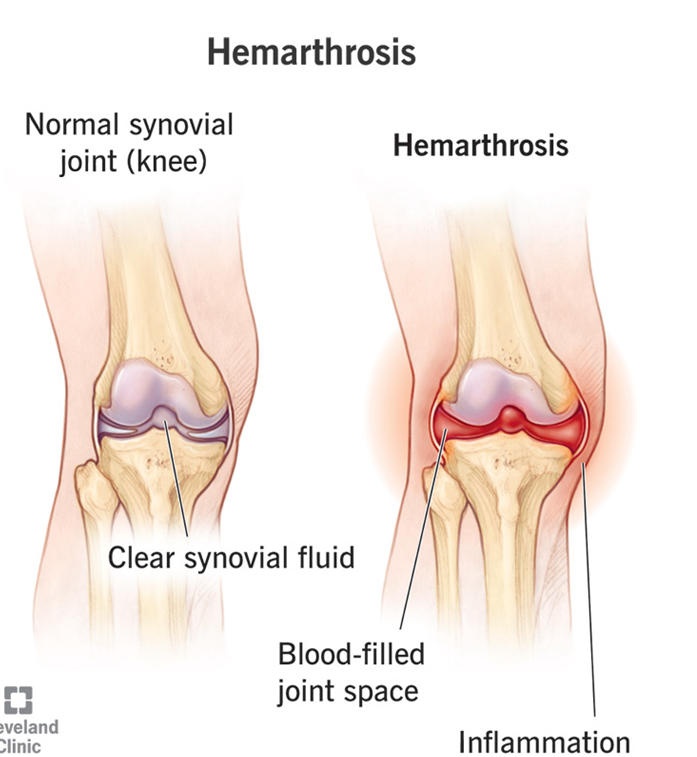Which of the following is included in the management of hemarthrosis in a child with hemophilia A?
Keep affected extremity below the level of the heart
Use of topical analgesic cream on the painful area
Instructing the parent to call their health care provider to obtain a plan of care
Prompt infusion of Factor VIII
The Correct Answer is D
Choice A reason:
Keeping the affected extremity below the level of the heart is not recommended in the management of hemarthrosis in a child with hemophilia A. Elevating the affected limb can help reduce swelling and pain by promoting venous return and decreasing pressure in the joint.
Choice B Reason:
The use of topical analgesic cream on the painful area is not a primary treatment for hemarthrosis in hemophilia A. While it may provide some temporary relief, it does not address the underlying issue of bleeding within the joint. The primary treatment involves replacing the missing clotting factor.
Choice C Reason:
Instructing the parent to call their health care provider to obtain a plan of care is important, but it is not the immediate management step for hemarthrosis. Prompt treatment with clotting factor replacement is crucial to stop the bleeding and prevent joint damage.
Choice D Reason:
Prompt infusion of Factor VIII is the primary treatment for hemarthrosis in a child with hemophilia A. This treatment helps to replace the missing clotting factor, stop the bleeding, and prevent further joint damage. Early intervention is essential to minimize complications and promote healing.

Nursing Test Bank
Naxlex Comprehensive Predictor Exams
Related Questions
Correct Answer is C
Explanation
Choice A reason:
Rye and oats: Rye contains gluten, which must be avoided by individuals with celiac disease. Oats, while naturally gluten-free, can often be contaminated with gluten during processing. Therefore, they should be introduced cautiously and only if labeled gluten-free.
Choice B Reason:
Wheat and corn: Wheat is a major source of gluten and must be strictly avoided by those with celiac disease. Corn, on the other hand, is naturally gluten-free and safe for consumption. However, since wheat is included in this option, it is not suitable for a gluten-free diet.
Choice C Reason:
Rice and soy: Both rice and soy are naturally gluten-free and safe for individuals with celiac disease. They are excellent alternatives to gluten-containing grains and provide essential nutrients.
Choice D Reason:
Barley and millet grain: Barley contains gluten and must be avoided by those with celiac disease. Millet is naturally gluten-free and safe for consumption. However, since barley is included in this option, it is not suitable for a gluten-free diet.
Correct Answer is C
Explanation
Choice A reason:
Weight gain is not a primary concern in the management of hypothyroidism in infancy. While hypothyroidism can lead to weight gain due to a slower metabolism, the more critical issue is the impact on brain development. Early and adequate treatment of hypothyroidism is essential to prevent intellectual disabilities and ensure normal neurocognitive outcomes.
Choice B Reason:
Rapid gut motility and diarrhea are not typical symptoms of hypothyroidism. In fact, hypothyroidism is more commonly associated with constipation due to a slower metabolism. Therefore, this choice is not relevant to the prompt management of hypothyroidism in infancy.
Choice C Reason:
Infancy is indeed a critical period for brain development. Untreated hypothyroidism during this time can lead to severe intellectual disabilities and developmental delays. Early diagnosis and treatment with thyroid hormone replacement are crucial to ensure normal brain development and cognitive function.
Choice D Reason:
Hyperactivity and irritability are not common symptoms of hypothyroidism. In fact, hypothyroidism often leads to lethargy and decreased activity levels. Therefore, this choice is not relevant to the prompt management of hypothyroidism in infancy.
Whether you are a student looking to ace your exams or a practicing nurse seeking to enhance your expertise , our nursing education contents will empower you with the confidence and competence to make a difference in the lives of patients and become a respected leader in the healthcare field.
Visit Naxlex, invest in your future and unlock endless possibilities with our unparalleled nursing education contents today
Report Wrong Answer on the Current Question
Do you disagree with the answer? If yes, what is your expected answer? Explain.
Kindly be descriptive with the issue you are facing.
